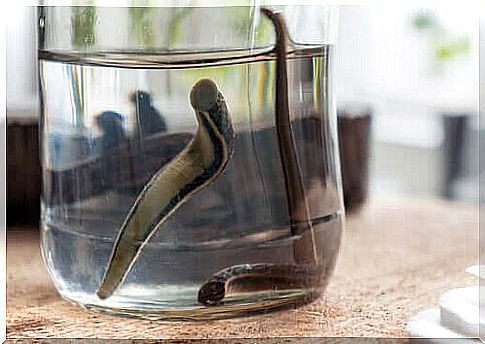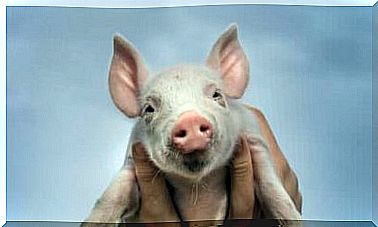Hirudo Medicinalis: The Medicinal Leech

The Hirudo medicinalis is a leech, an invertebrate, more specifically an annelid belonging to the family Hirudinidae . This species of leech has been widely used in medicine throughout history.
Background
Records mentioning the therapeutic use of leeches date back to the ancient civilizations of Egypt, Greece, Rome and Mesopotamia. During the Middle Ages, leeches were also applied in different treatments.
This was because of the belief that the body was composed of four humors: blood, phlegm, yellow bile, and black bile. Changing the balance between humors would cause different pathologies.
Thus, the elimination of the most important mood, the contaminated blood, was essential to restoring balance. For this, bloodletting was performed, or leech therapy was applied.
Anatomy of Hirudo medicinalis
The Hirudo medicinalis is a hermaphrodite worm targeted belonging to the group of annelids and family Hirudinidae . It is this species, of more than 600 existing, the most valued in the field of medicine.
The length it can reach is 12 centimeters when fed. If it has not been fed, its size is a third of what was mentioned. This animal is characterized by having two suckers with suction capacity.
The two cups are located in different positions: a small, mobile oral cup with three jaws, through which it sucks blood. In each jaw, it has approximately 60 to 100 teeth, which gives the bite a ‘Y’ shape.
On the other hand, the remaining cup, called the anal cup, is what it uses to adhere at first, and also to drag itself.
Saliva components of Hirudo medicinalis
The salivary glands of Hirudo medicinalis secrete a series of components that have different therapeutic properties. Among them, the following can be mentioned:
- Anticoagulants. The main substance is hirudin, which inhibits the clotting action of thrombin.
- Vasodilators. Different substances similar to histamine, among others, facilitate blood flow because they cause the arteries to dilate.
- Anesthetics. The bite is painless because of the anesthetic substances that the leech inoculates.
- Anti-inflammatory drugs.
- Antimicrobials.
- Proteolytic enzymes.

How to use Hirudo medicinalis
The leech therapy is called hirudotherapy. The leeches are preserved in glass vials, closed with a damp compress, kept in a cool place; they cannot be hermetically sealed.
To manipulate the leeches, dissecting forceps are used, holding them with a glass cup. Thus, their displacement is avoided and they are kept in the ideal place. The skin should be clean, and if the worm does not bite easily, it should be soaked in sugar water.
After receiving the leeches, which come loose when they are filled with blood, serosity flows through the incision for hours. Therefore, an uncompressed cotton dressing is applied, which is removed and replaced by another the next day to observe the evolution.
A few days later, the area of the hematoma shows a considerable improvement. If the leech, although full, does not come loose, it is advisable to apply salt water. Thus, it is possible to facilitate its release and prevent infections by trying to pull it out for removal.
The leeches are for single use only. Once used, they must be confined and incinerated. No cases of bite infection were registered.

Pathologies in whose treatments hirudotherapy has already been applied
Among the pathologies that have already been treated with this technique with leeches, the following stand out:
- Inflammatory joint processes.
- Reconstructive plastic surgery.
- Migraine.
- Hemorrhoidal thrombosis.
- Chronic topical eczema.
A story told about the pilgrims who walked the Camino de Santiago centuries ago is that they rested near lakes and rivers. There, they refreshed themselves and soothed the tiredness of the way. Here, they had unexpected allies.
The leeches relieved edema and prevented the onset of thromboembolic diseases.
Advantages and contraindications of hirudotherapy
Hirudotherapy does not cause side effects or negative consequences. Plus, it’s safe and completely painless. On the other hand, it is necessary to mention that there are several contraindications.
Among the contraindications, its use in immunosuppressed patients or with arterial insufficiency is not accepted. Likewise, the possible risk of infection by Aeromonas hydrophila must be informed.
This bacterium has a symbiotic relationship with H. medicinalis – it lives in your gut – and, in turn, secretes enzymes that facilitate the digestion of blood.
Above all, hirudotherapy is only used in cases where absolutely no other solution can be found. The patient must always be informed and give consent.
Finally, it should be noted that its use is only intra-hospital.









